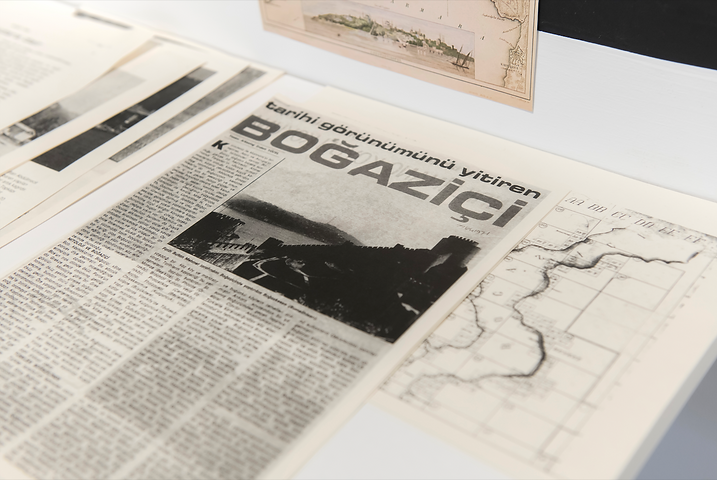
Solo Exhibition
“In today's mode of production, first and tangible success is primarily taken into account in the face of nature as well as in society.” Friedrich Engels
The shores of the Bosporus, which has been the subject of the writings of many travellers, writers and historians for centuries, kept the architectural identity that was passed on to us until recently. However, with the increase in the population as a result of the migrations since the 1980s, the city began growing towards the sea, losing its natural borders.
The material used to fill the sea was excavations of buildings that were demolished at different points of the city.
Indicating the fill areas that have been added to Bosphorus since the 17th century corresponds to the size of a Istanbul district, Berka Beste Kopuz takes the audience to a new district of Istanbul both well-known and not known at all: Kazıklıköy.
In the exhibition that focuses on the topography of the 40 districts and neighbourhoods of the Bosporus, the artist reveals the destruction of uncontrolled and improper planning after privatization, sharing archival footage from her walks around these districts with the audience.
Berka Beste Kopuz’s large-scale black and white photographs convey the rapid growth and outcomes of the city occupation with an abstract expression. Looking carefully at these photos, the submerged
Istanbul is seen. Filling of the sea and narrowing of the Bosphorus, demolished buildings and destroyed lives to create new living spaces indicate the excavations that constitute the fillings of Kazıklıköy.
‘The difference between the plans and outcomes of these projects can be understood in the open compositions of the artist’s photographs: the gap between what is demanded and what is realized is massive. The non-representative, as in works that do not seem to be referencing the real world, the difference between the promised and reality can be clearly seen. Beste Kopuz visualizes for us how history is invaded to accommodate the political and economic rents of governments, and not to accommodate humanity. At this point there is no consideration of public welfare; the easily visible coastal history of Istanbul where we could indulge in nostalgia disappears behind a curtain of mystery. There is an image behind it, but we cannot see it, just like the coast protection acts that are never enforced although they exist.’
Fırat Arapoglu
Kazıklıköy exhibition is composed of large scale black and white photographs, archival and satellite images, lightboxes, maps and an installation of the Bosporus and the excavations while also housing an interactive installation where the artist invites the audience to share the archival sources about the Bosporus.

Bosphorus Archive,
interactive installation,
2019




On the Coast on the Past
interactive installation
119x132x40cm
35 pieces plexiglass
2019

On the Coast on the Past
Detail


Trace series,
Diasec print,
2019

New District: "Kazıklıköy"

The story of "Kazıklıköy"

“Kazıklıköy”
Lightbox
Digital collage
60x60cm
2019

Kazıklıköy,
Installation,
260x147x7cm,
2019

Sola Aquas
Installation,
2019



“Artifakt” Series,
7 pieces, 40x40cm
Digital Collage and ind draw
Fine art print
2019

Area
2 pieces/50x70cm
Digital Collage
Pigment Print
2014
